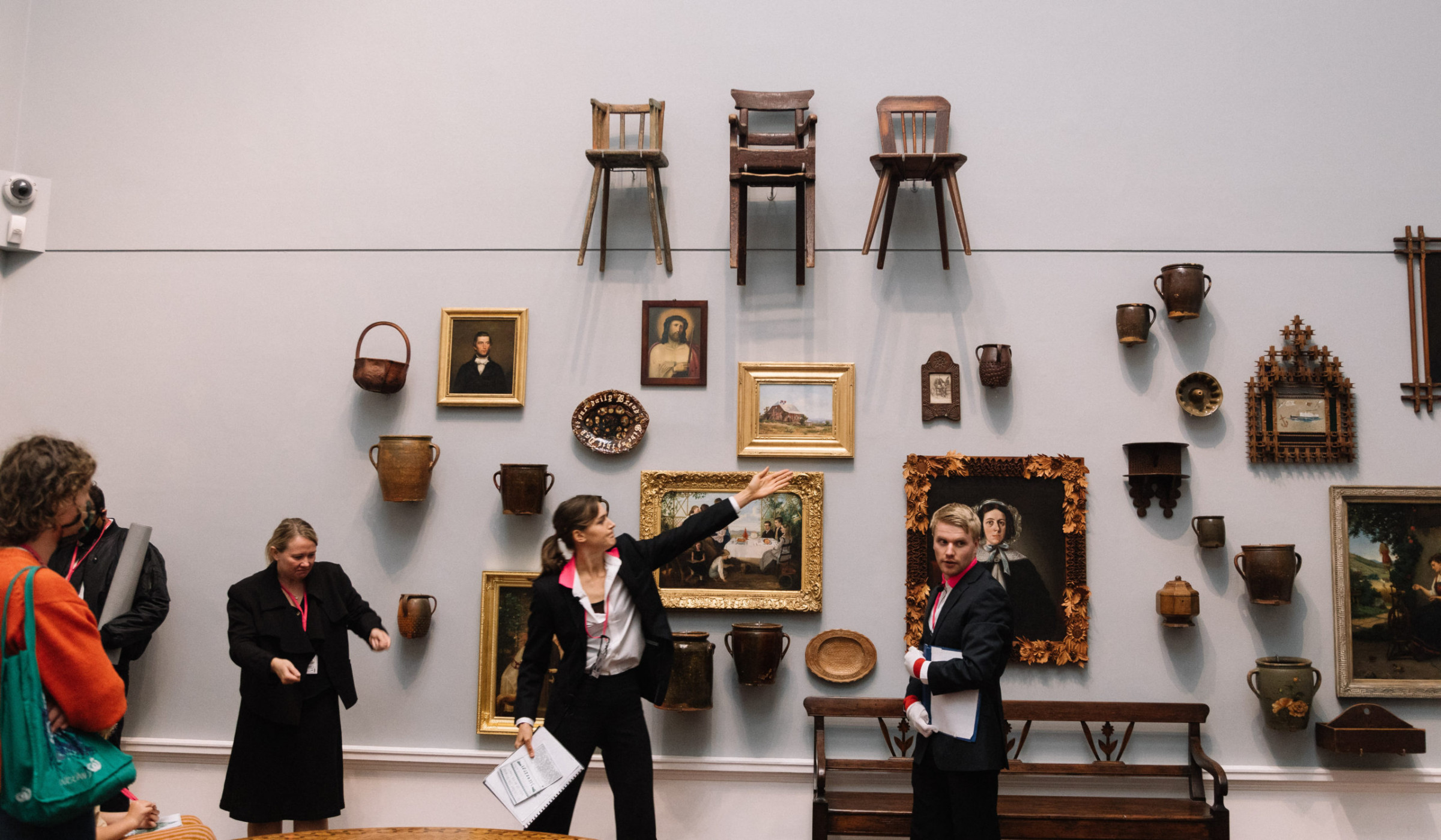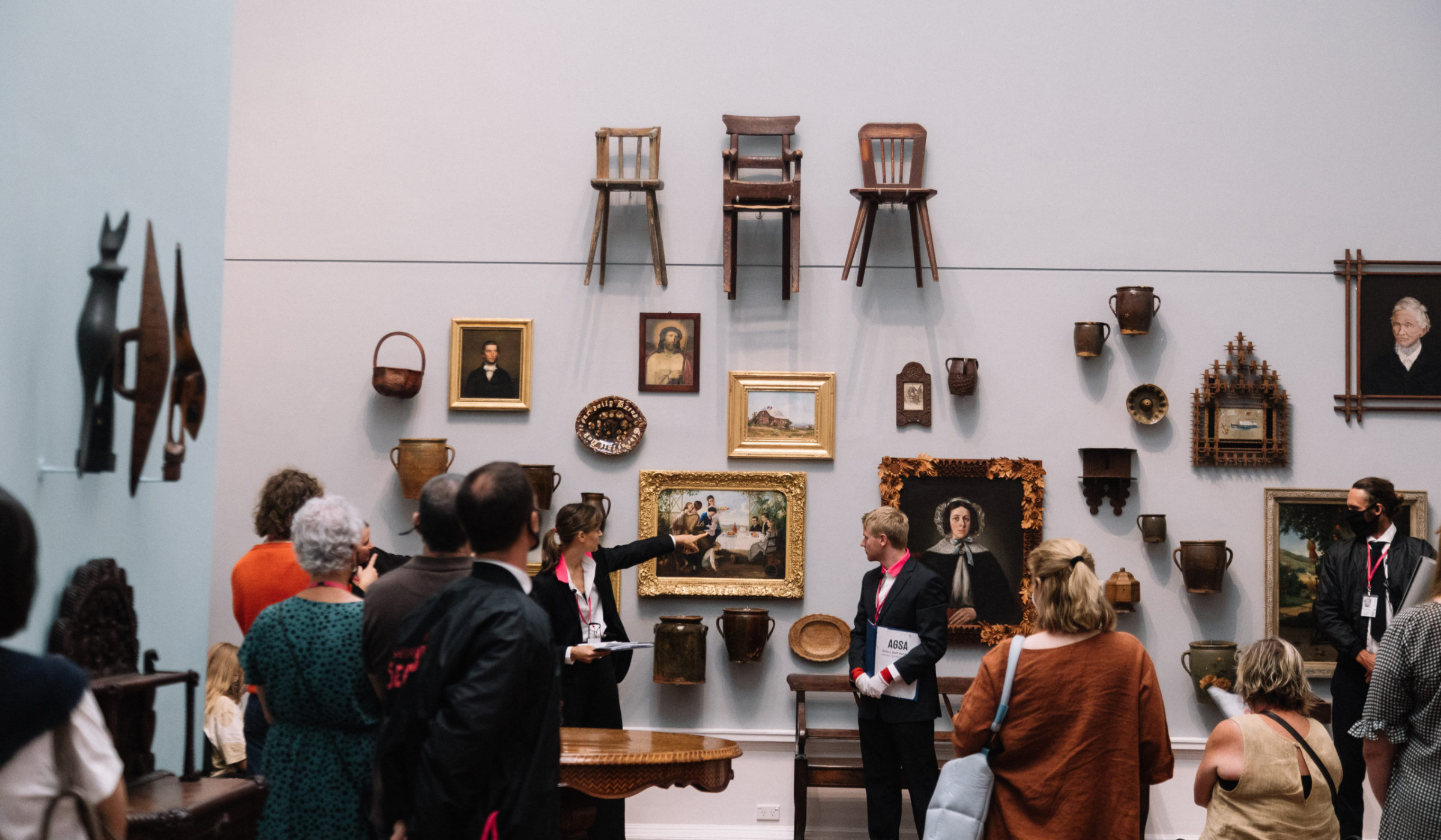What could two stuffy staffers from the fictitious Australian Bureau of Cultural Dietetics and Eating For Good Health (ABCDEFGH) tell us about the nutritional value of Art Gallery of South Australia's collection? An entire buffet-worth, apparently.
An artful degustation with ‘Nutritional Index’
Four stony-faced security guards wearing earpieces, sunglasses and black bus-driver jackets, with “Art Gallery of South Australia SECURITY” scrawled on the back, hand us pink lanyards.
These passes grant us entry to the Adelaide Fringe performance Nutritional Index, which is a food-infused, faux-government-led tour of the Art Gallery of South Australia.
‘Nutritional Index’
Now showing as part of the Adelaide Fringe
3pm—4:30pm Sat 26 Feb 2022
Art Gallery of South Australia
North Terrace, Adelaide 5000
Smoothie included.
More info here.
“We have been subcontracted by AGSA and we don’t usually work here,” Emmaline Zanelli, one of the tour guides, tells the crowd gathered in Gallery 15.
“Our bread and butter, our day to day, is working for the Australian Bureau of Cultural Dietetics and Eating For Good Health – ABCDEFGH for short.
“We’ve been working with AGSA to look through the collection for the nutritional benefits of the art, and whether we have any suggestions moving forward.”
Emmaline, wearing a black pinstripe suit (with comical pops of pink) and styling a slick, low ponytail, is a photographer and member of the multidisciplinary arts collective The Bait Fridge. She’s joined by visual artist Kurt Bosecke from Tutti Arts, who’s also a Bait Fridge collaborator. He wears what he describes as a “financial suit” and black brogues.
“Guess what? I’m going to be your tour guide for the Nutritional Index art gallery tour,” Kurt quips.
Over the next hour, we’re shepherded through AGSA and fed knowledge of the omnivorous, vegetarian, vegan, carnivorous, pescatarian and gluten-rich artworks.
Some of the explored pieces include still life paintings depicting fish and fruit, Yayoi Kusama’s iconic dotted pumpkin sculpture, “digestible” art made from natural fibres that can be devoured by bugs over time, and Indigenous Australian animal traps and paintings.
But there is more than just the regurgitation of information. CityMag is called out of the crowd halfway through the performance (It’s great to have media here,” Emmaline says), and two of the tallest security guards take a moment mid-tour to complete a series of exercises on yoga mats.
“We’re going to look at some exercises used, or practiced daily, to develop these kinds of muscles,” Emmaline says, pointing to Auguste Rodin’s The Walking Man bronze sculpture. She delivers the line with the kind of authority garnered through delivering thousands of banal PowerPoint presentations.
“Push-ups,” Kurt adds, with a puckish smile. We’re stood before this piece to learn about the ideal body.

Authoritative guides
At the end of the tour, after the duo metaphorically shed their suits and personas, Emmaline tells CityMag although she and Kurt were given access to most of the gallery’s 38,000 works, spread over multiple storage facilities, touching Rodin’s bust brought them the most joy.
“I think we liked that he was ripped and we could touch it,” she says.
“Out of 16 of us, probably only two of us can really touch his pecks, torso, and obliques,” Kurt says.
Nutritional Index was developed through a collaboration between disability arts organisation Tutti Arts and the Art Gallery of South Australia. The aim, Emmaline says, was to connect institutions, such as the gallery, to Tutti artists.
The pair developed Nutritional Index over the span of a year, visiting the gallery regularly with the aim of viewing the collection through a new lens.
As Kurt sips a smoothie – made at the end of the performance and full of ingredients seen in the artworks – his interest in nourishment is clear.
“I’m an omnivore,” he says, “but how about you?” We admit to being herbivorous (aka vegan).
Emmaline says they both wanted to approach the performance by stepping out of their comfort zones, which are visual arts and poetry, respectively.
Kurt’s passion for food led to their decision to interrogate AGSA’s collection through a flavourful framework.
“I like cooking and eating at the same time,” he says.
The faux-government employee characters they’ve created came from their shared interest in unpacking who an archetypal tour guide is. This was bolstered by Kurt’s interest in mysterious, half-alien authoritative figures found in films such as Men in Black and The Matrix.
Emmaline believes for cultural institutions to remain relevant to their communities, they need to make room for visitors to ask questions and spend meaningful time there.
“The work is certainly playful, but what I think we were really doing in the space of the cultural institution that was important was requesting a dialogue,” she says.
“This dialogue and having the gallery feel open to us asking some questions and looking behind the scenes allowed for us to then feel that we could be playful in the gallery.”









